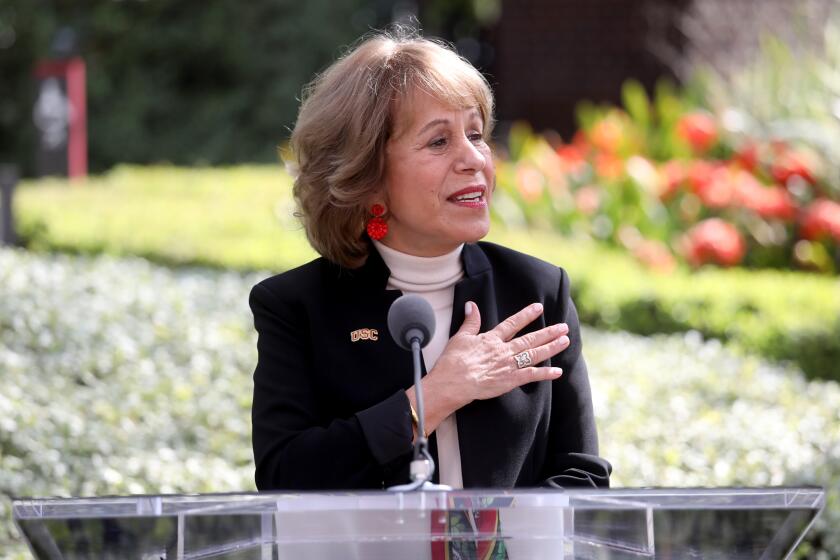Enrolling in the Computer Age : University Students Register by Phone With a Talking Machine
Cory Elliott took an unexpected drive recently.
A business administration major at Cal State Long Beach, he was scheduled to enroll in next semester’s classes via telephone on the university’s new computerized registration system. But at the last minute he realized that his Lakewood home was not equipped with the required touch-tone phone.
So Elliott, 19, drove half a mile to the neighborhood convenience store. Standing at a pay phone in the parking lot, holding a class schedule in one hand and plugging his free ear against the noise of traffic with the other, he enrolled in five classes by punching a series of 4-digit codes on the telephone’s button panel.
“You have completed your registration for the spring, 1989 semester,” the computer’s authoritative-sounding male voice told him at the end of his 6-minute call. “Thank you. Goodby.”
Said a beaming Elliott: “I’m impressed. I really like it.”
Not everyone shares his glowing assessment of the new registration system, arguing that it is unreliable and prone to security breaches. Even some of the critics, however, admit that it beats the old method of sending in class-request cards, waiting up to two months for confirmation by return mail and then standing in line for as long as three hours to add classes that initially were unavailable.
Regardless of personal opinion, one thing was abundantly clear last week: the computer age has arrived at Cal State Long Beach. It is called OASIS--an acronym for Online Administrative Student Information System--and administrators say it is revolutionizing the way things are done on the 34,000-student campus. “I think it’s outstanding,” said Ernie Huff, the system’s director. “It’s accomplishing what we want to do administratively as well as giving better service to students.”
Although at least 50 other institutions throughout the country use such systems, Huff said, Cal State Long Beach was the first major university in California to do so. Cal Poly San Luis Obispo a much smaller campus, has come on line more recently. And several other campuses, ranging from USC to Cal State Los Angeles, are either considering or planning similar systems.
The Long Beach system was developed with Cal State L.A. and Cal Poly San Luis Obispo, in fact, as part of a pilot project funded by the university system and two private companies--IBM and Information Associates--which plan to eventually market it commercially. While each of the three campuses is contributing $1 million to the project over a 3-year period, Huff said, the two companies have given a total of $7.84 million.
In Long Beach, the system was first tested last summer when 6,000 new students attending an orientation program registered over a 6-week period from 32 telephones placed in a room on campus. By the middle of last week--just 7 days after the system went up permanently--about 5,000 more students had enrolled from home or pay telephones throughout the area. And by the time pre-registration ends on Nov. 28, Huff said, at least 25,000 students are expected to have used the new computer system to sign up for classes during phone calls averaging four minutes in duration.
Other Functions
Besides registration, he said, the system will eventually handle admissions, academic records, financial aid and billing receivables.
Here is how it works: When a student calls to register, Huff said, the call is answered by a 4-foot-high beige box equipped with 32 flashing red and green lights--one for each telephone line--and located in the Administration Building. Identifying the caller by Social Security number, the box then communicates with a mainframe computer in the library across campus, relaying pertinent information and instructions back to the student in a digitized human voice.
When a caller punches in the code of a desired course, Huff said, the computer checks availability, then either enrolls the student immediately or searches for the nearest available time slot.
“The value is that it gives feedback immediately,” said Huff. As a result, he said, the university expects to significantly reduce the 150,000 post-registration requests it routinely processes each semester for adding or dropping classes, probably at an eventual savings of about $75,000 per year.
Lack of Security
But the system is not without glitches.
Because Social Security numbers are often listed alongside students’ names on class rosters, some critics have charged, the computer is prone to manipulation by unscrupulous callers who, using other students’ numbers, could sign on and drop their adversaries from highly sought classes in order to later substitute themselves. To guard against that, Huff said, professors are being urged to stop listing full Social Security numbers on their rosters and student registrants in future years will be assigned secret code numbers by which to identify themselves.
The biggest glitch so far, however, came last week when the system went down for 8 1/2 hours on a day that 1,600 seniors were scheduled to enroll in classes that many need to graduate, a situation resulting in angry knots of frantic complainers lined up at pay phones all over campus.
“We were ready to tear the phones out this morning,” said Susanne Kipp, 36, a journalism major who claimed that she had unsuccessfully dialed the computer’s number at least 500 times between 7 a.m. and 3:30 p.m., when she finally got through. “We were considering planting bombs, starting a strike or beginning a revolution.”
Said radio and television major Art Lew, 22: “This is like phoning a radio station for a prize. Humans you can at least chew out; this is just a machine.”
More to Read
Start your day right
Sign up for Essential California for news, features and recommendations from the L.A. Times and beyond in your inbox six days a week.
You may occasionally receive promotional content from the Los Angeles Times.






